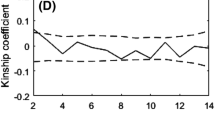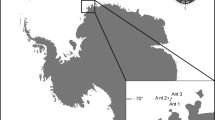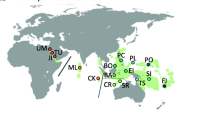Abstract
Sponges display a variety of reproductive strategies that have the potential to influence population genetic structure. Histological examination of ten reproductive individuals of the Western Australian sponge Haliclona sp. showed that this species broods embryonic larvae that are potentially limited in dispersal capabilities. Because sponges have the potential to propagate in a number of modes, allozyme electrophoresis was used to assess the relative importance of asexual and sexual reproduction to recruitment, and to quantify genetic subdivision over different spatial scales. Tissue samples from 227 sponges were collected from reefs within two areas 400 km apart: Hamelin Bay and Rottnest Island. Contrary to expectations for highly clonal populations, genotypic diversity within sites was high, no linkage disequilibrium was found, and there was no evidence of genotypic clustering within reefs. There was no genetic evidence that asexual reproduction is important for the maintenance of populations. Genetic comparisons were consistent with mixing of sexually produced recruits within reefs, on a scale up to a few hundred metres, but significant genetic subdivision between reefs (FST=0.069 at Hamelin Bay, 0.130 at Rottnest Island) indicated that water gaps of several hundred metres are effective at preventing dispersal. Subdivision between the two areas, separated by 400 km, was moderately greater (FST=0.142) than within, but the same alleles were predominant in the two areas. These genetic patterns are consistent with limited dispersal capabilities of brooded larvae.




Similar content being viewed by others
References
Ayling AL (1980) Patterns of sexuality, asexual reproduction and recruitment in some subtidal marine Demospongiae. Biol Bull 158:271–282
Ayre DJ (1984) The effects of sexual and asexual reproduction on geographic variation in the sea anemone Actinia tenebrosa. Oecologia 62:222–229
Ayre DJ, Hughes TP (2000) Genotypic diversity and gene flow in brooding and spawning corals along the Great Barrier Reef, Australia. Evolution 54:1590–1605
Ayre DJ, Davis AR, Billingham M, Llorens T, Styan C (1997a) Genetic evidence for contrasting patterns of dispersal in solitary and colonial ascidians. Mar Biol 130:51–61
Ayre DJ, Hughes TP, Standish RJ (1997b) Genetic differentiation, reproductive mode, and gene flow in the brooding coral Pocillopora damicornis along the Great Barrier Reef, Australia. Mar Ecol Prog Ser 159:175–187
Bastidas C, Benzie JAH, Fabricuis KE (2002) Genetic differentiation among populations of the brooding soft coral Clavularia koellikeri on the Great Barrier Reef. Coral Reefs 21:233–241
Battershill CN, Bergquist PR (1990) The influence of storms on asexual reproduction, recruitment and survivorship of sponges. In: Rutzler K (ed) New perspectives in sponge biology. Smithsonian Institution Press, Washington, D.C., pp 397–404
Benzie JAH, Sandusky C, Wilkinson CR (1994) Genetic structure of dictyoceratid sponge populations on the western Coral Sea reefs. Mar Biol 119: 335–345
Bergquist PR (1978) Sponges. Hutchinson, London
Bergquist PR, Sinclair ME (1968) The morphology and behaviour of larvae of some intertidal sponges. N Z J Mar Freshwat Res 2:426–437
Black R, Johnson MS (1979) Asexual viviparity and population genetics of Actinia tenebrosa. Mar Biol 53:27–31
Corriero G, Scalera Liaci L, Nonnis Marzano C, Gaino E (1998) Reproductive strategies of Mycale contarenii (Porifera: Demospongiae). Mar Biol 131:319–327
Davis AR, Ayre DJ, Billingham MR, Styan CA, White GA (1996) The encrusting sponge Halisarca laxus: population genetics and association with the ascidian Pyrua spinifera. Mar Biol 126:27–33
Denny M, Dairiki J, Distefano S (1992) Biological consequences of topography on wave swept rocky shores I. Enhancement of external fertilisation. Biol Bull 183:220–232
Duran S, Pascual M, Estoup A, Turon X (2002) Polymorphic microsatellite loci in the sponge Crambe crambe (Porifera: Poesilosclerida) and their variation in two distant populations. Mol Ecol Notes 2:478–480
Duran S, Pascual M, Turon X (2004) Low levels of genetic variation in mt DNA sequences over the western Mediterranean and Atlantic range of the sponge Crambe crambe (Poecilosclerida). Mar Biol 144:31–35
Erickson KL, Beytal JA, Cardellina II, Boyd MR (1997) Salicylihamides A and B, novel cytotoxic macrolides from the marine sponge Haliclona sp. J Org Chem 62:8188–8192
Fromont J (1994) Reproductive development and timing of tropical sponges (Order Haplosclerida) from the Great Barrier Reef, Australia. Coral Reefs 13:127–133
Fromont J (1999) Reproduction of some demosponges in a temperate Australian shallow water habitat. Mem Qld Mus 44:185–192
Garson MJ, Thompson JE, Larsen RM, Battershill CN, Murphy PT, Bergquist PR (1992) Terpenes in sponge cell membranes: cell separation and membrane fractionation studies with the tropical marine sponge Amphimedon sp. Lipids 27:378–388
Hellberg ME (1996) Dependence of gene flow on geographic distance in two solitary corals with different larval dispersal capabilities. Evolution 50:1167–1175
Jackson JBC (1986) Modes of dispersal of clonal benthic invertebrates: consequences for species distributions and genetic structure of local populations. Bull Mar Sci 39:588–606
Johnson MS, Black R (1984) The Wahlund effect and the geographical scale of variation in the intertidal limpet Siphonaria sp. Mar Biol 79:295–302
Johnson MS, Bentley SL, Ford SS, Ladyman MT, Lambert GJ (2001) Effects of a complex archipelago on genetic subdivision of the intertidal limpet Siphonaria kurracheensis. Mar Biol 139:1087–1094
Klautau M, Russo CAM, Lazoski C, Boury-Esnault N, Thorpe JP, Sole-Cava AM (1999) Does cosmopolitanism result from overconservative systematics? A case study using the marine sponge Chondrilla nucula. Evolution 53:1414–1422
Maldonado M Young CM (1996) Effects of physical factors on larval behaviour, settlement and recruitment of four tropical demosponges. Mar Ecol Prog Ser 138:169–180
Mariani S, Uriz MJ, Turon X (2000) Larval bloom of the oviparous sponge Cliona viridis: coupling of larval abundance and adult distribution. Mar Biol 137:783–790
McFadden CS (1997) Contributions of sexual and asexual reproduction to population structure in the clonal soft coral, Alcyonium rudyi. Evolution 51:112–126
Meroz K, Ilan M (1995) Life history characteristics of a coral reef sponge. Mar Biol 124:443–451
Miller KJ (1997) Genetic structure of black coral populations in New Zealand’s fiords. Mar Ecol Prog Ser 161:123–132
Miller K, Alverez B, Battershill C, Nortcote P, Parthasarathy H (2001) Genetic, morphological, and chemical divergence in the sponge genus Latrunculia (Porifera: Demospongiae) from New Zealand. Mar Biol 139:235–250
Palumbi SR (1994) Genetic divergence, reproductive isolation, and marine speciation. Annu Rev Ecol Syst 25:547–572
Raymond M, Rousset F (1995) GENEPOP (version 1.2): population genetics software for exact tests and ecumenicism. J Hered 86:248–249
Selander RK, Smith MH, Yang SH, Johnson WE, Gentry JB (1971) Biochemical polymorphism and systematics in the genus Peromyscus I. Variation in the old-field mouse (Peromyscus polionotus). Studies in genetics 6. (University of Texas publication 7103) University of Texas, Austin, pp 49–90
Stoddart JA (1983) Asexual production of planulae in the coral Pocillopora damicornis. Mar Biol 76:279–284
Stoddart JA (1984) Genetical structure within populations of the coral Pocillopora damicornis. Mar Biol 81:19–30
Thompson AP, Hanley JR, Johnson MS (1996) Genetic structure of the western rock lobster, Panulirus cygnus, with the benefit of hindsight. Mar Freshw Res 47:889–896
Threlfall TJ, Johnson MS (1987) Fissiparity and population genetics of Coscinasterias calamaria. Mar Biol 93:517–525
Weir BS, Cockerham CC (1984) Estimating F-statistics for the analysis of population structure. Evolution 34:1358–1370
Williams ST, Benzie JAH (1993) Genetic consequences of long larval life in the starfish Linckia laevigita (Echinodermata: Asteroidea) on the Great Barrier Reef. Mar Biol 117:71–77
Woollacott RM (1993) Structure and swimming behaviour of the larva of Haliclona tubifera (Porifera: Demospongiae). J Morphol 218:301–321
Wulff JL (1986) Variation in clone structure of fragmenting coral reef sponges. Biol J Linn Soc 27:311–330
Acknowledgements
D. Abdo, D. Gull, N. Harman, B. Toohey, M. Kleczkowski, C. McDonald, and J. Henda assisted in collecting samples. We thank R. de Nys, D. Jerry, and two anonymous reviewers for comments on an earlier version of this manuscript. We acknowledge the histology work done by T. Stewart. This work was allied to an aquaculture study of the sponge funded by a Fisheries Research and Development Corporation (Australia) grant to CB and EH. Additional financial support was provided by the Departments of Botany and Zoology, University of Western Australia.
Author information
Authors and Affiliations
Corresponding author
Additional information
Communicated by G.F. Humphrey, Sydney
Rights and permissions
About this article
Cite this article
Whalan, S., Johnson, M.S., Harvey, E. et al. Mode of reproduction, recruitment, and genetic subdivision in the brooding sponge Haliclona sp.. Marine Biology 146, 425–433 (2005). https://doi.org/10.1007/s00227-004-1466-8
Received:
Accepted:
Published:
Issue Date:
DOI: https://doi.org/10.1007/s00227-004-1466-8




